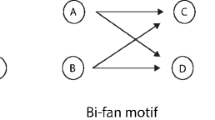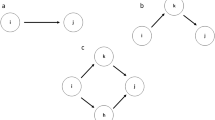Abstract
Social interactions are critical to the organization of worker activities in insect colonies and their consequent ecological success. The structure of this interaction network is therefore crucial to our understanding of colony organization and functioning. In this paper, I study the properties of the interaction network in the colonies of the social wasp Ropalidia marginata. I find that the network is characterized by a uniform connectivity among individuals with increasing heterogeneity as colonies become larger. Important network parameters are found to be correlated with colony size and I investigate how this is reflected in the organization of work in colonies of different sizes. Finally, I test the resilience of these interaction networks by experimental removal of individuals from the colony and discuss the structural properties of the network that are related to resilience in a social network.




Similar content being viewed by others
References
Albert R, Jeong H, Barabási A (2000) Error and attack tolerance of complex networks. Nature 406:378–382
Amaral LAN, Scala A, Barthélemy M, Stanley HE (2000) Classes of small-world networks. Proc Natl Acad Sci U S A 97:11149–11152
Anderson C, Ratnieks FLW (1999) Task partitioning in insect societies. I. Effect of colony size on queueing delay and colony ergonomic efficiency. Am Nat 154:521–535
Barabási A, Albert R (1999) Emergence of scaling in random networks. Science 286:509–512
Beshers SN, Huang ZY, Oono Y, Robinson GE (2001) Social inhibition and the regulation of temporal polyethism in honey bees. J Theor Biol 213:461–479
Bonabeau E, Dorigo M, Theraulaz G (2000) Inspiration for optimization from social insect behaviour. Nature 406:39–42
Camazine S, Deneubourg JL, Franks NR, Sneyd J, Theraulaz G, Bonabeau E (2001) Self-organization in biological systems. Princeton University Press, Princeton
Crailsheim K (1998) Trophallactic interactions in the adult honeybee (Apis mellifera L.). Apidologie 29:97–112
Croft DP, Krause J, James R (2004) Social networks in the guppy (Poecilia reticulata). Proc R Soc Lond B (Suppl) 271:S516–S519
Dunne JA, Williams RJ, Martinez ND (2002a) Food-web structure and network theory: the role of connectance and size. Proc Natl Acad Sci U S A 99:12917–12922
Dunne JA, Williams RJ, Martinez ND (2002b) Network structure and biodiversity loss in food webs: robustness increases with connectance. Ecol Lett 5:558–567
Fewell JH (2003) Social insect networks. Science 301:1867–1870
Fewell JH, Bertram SM (1999) Division of labor in a dynamic environment: response by honeybees (Apis mellifera) to graded changes in colony pollen stores. Behav Ecol Sociobiol 46:171–79
Gautrais J, Theraulaz G, Deneubourg JL, Anderson C (2002) Emergent polyethism as a consequence of increased colony size in insect societies. J Theor Biol 215:363–373
Gordon DM (1999) Interaction patterns and task allocation in ant colonies. In: Detrain C, Deneubourg JL, Pasteels JM (eds) Information processing in social insects. Birkhäuser Verlag, Basel, pp 51–67
Gordon DM, Goodwin BC, Trainor LEH (1992) A parallel distributed model of the behavior of ant colonies. J Theor Biol 156:293–307
Gordon DM, Paul RE, Thorpe K (1993) What is the function of encounter patterns in ant colonies? Anim Behav 45:1083–100
Huang ZY, Robinson GE (1992) Honeybee colony integration—worker–worker interactions mediate hormonally regulated plasticity in division of labor. Proc Natl Acad Sci U S A 89:11726–29
James R, Croft DP, Krause J (2009) Potential banana skins in animal social network analysis. Behav Ecol Sociobiol. doi:10.1007/s00265-009-0742-5
Jeanne RL (1999) Group size, productivity, and information flow in social wasps. In: Detrain C, Deneubourg JL, Pasteels JM (eds) Information processing in social insects. Birkhäuser Verlag, Basel, pp 3–30
Jeanson R, Fewell JH, Gorelick R, Bertram SM (2007) Emergence of increased division of labor as a function of group size. Behav Ecol Sociobiol 62:289–298
Karsai I, Wenzel JW (1998) Productivity, individual-level and colony-level flexibility, and organization of work as consequences of colony size. Proc Natl Acad Sci U S A 95:8665–8669
Krause J, Croft DP, James R (2007) Social network theory in the behavioural sciences: potential applications. Behav Ecol Sociobiol 62:15–27
Krause J, Lusseau D, James R (2009) Animal social networks: an introduction. Behav Ecol Sociobiol. doi:10.1007/s00265-009-0747-0
Lusseau D (2003) The emergent properties of a dolphin social network. Proc R Soc Lond B 240:S186–S188
Mailleux A-C, Deneubourg JL, Detrain C (2003) How does colony growth influence communication in ants? Insectes Soc 50:24–31
Naug D (2001) Ergonomic mechanisms for handling variable amounts of work in colonies of the wasp Ropalidia marginata. Ethology 107:1115–1123
Naug D (2008) Structure of the social network and its influence on transmission dynamics in a honeybee colony. Behav Ecol Sociobiol 62:1719–1725
Naug D, Camazine S (2002) The role of colony organization in pathogen transmission in social insects. J Theor Biol 215:427–439
Naug D, Gadagkar R (1999) Flexible division of labor mediated by social interactions in an insect colony: a simulation model. J Theor Biol 97:123–33
Naug D, Smith BH (2007) Experimentally induced change in infectious period affects transmission dynamics in a social group. Proc R Soc Lond B 274:61–65
Naug D, Wenzel J (2006) Constraints on foraging success due to resource ecology limit colony productivity in social insects. Behav Ecol Sociobiol 60:62–68
Newman MEJ (2003) The structure and function of complex networks. SIAM Rev 45:167–256
Nicolis SC, Theraulaz G, Deneubourg JL (2005) The effect of aggregates on interaction rate in ant colonies. Anim Behav 69:535–540
O’Donnell S (1998) Effects of experimental forager removals on division of labour in the primitively eusocial wasp Polistes instabilis (Hymenoptera: Vespidae). Behaviour 135:173–193
O’Donnell S, Bulova SJ (2007a) Worker connectivity: a review of the design of worker communication systems and their effects on task performance in insect societies. Insect Soc 54:203–210
O’Donnell S, Bulova SJ (2007b) Worker connectivity: a simulation model of variation in worker communication and its effects on task performance. Insect Soc 54:211–218
Oster GF, Wilson EO (1978) Caste and Ecology in the Social Insects. Princeton University Press, Princeton
Pacala SW, Gordon DM, Godfray HCJ (1996) Effects of social group size on information transfer and task allocation. Evol Ecol 10:127–165
Schmid-Hempel P (1998) Parasites in social insects. Princeton University Press, Princeton
Seeley TD (1979) Queen substance dispersal by messenger workers in honeybee colonies. Behav Ecol Sociobiol 5:391–395
Seeley TD (1995) The wisdom of the hive: the social physiology of honey bee colonies. Harvard University Press, Cambridge
Thomas ML, Elgar MA (2003) Colony size affects division of labour in the ponerine ant Rhytidoponera metallica. Naturwissenschaften 90:88–92
van Honk C, Hogeweg P (1981) The ontogeny of the social structure in a captive Bombus terrestris colony. Behav Ecol Sociobiol 9:111–119
Watts DJ, Strogatz SH (1998) Collective dynamics of ‘small-world’ networks. Nature 393:440–442
Wilson EO, Hölldobler B (1988) Dense heterarchies and mass communication as the basis of organization in ant colonies. Trends Ecol Evol 3:65–68
Wilson EO, Hölldobler B (2005) Eusociality: Origin and consequences. Proc Natl Acad Sci U S A 102:13367–13371
Acknowledgements
I would like to thank Jens Krause for inviting me to be a part of this special issue on social networks and Dick James and David Lusseau for their most insightful comments that forced me to think and work hard for the final version of this paper.
Author information
Authors and Affiliations
Corresponding author
Additional information
Communicated by J. Krause
This contribution is part of the special issue “Social Networks: new perspectives” (Guest Editors: J. Krause, D. Lusseau, and R. James).
Rights and permissions
About this article
Cite this article
Naug, D. Structure and resilience of the social network in an insect colony as a function of colony size. Behav Ecol Sociobiol 63, 1023–1028 (2009). https://doi.org/10.1007/s00265-009-0721-x
Received:
Revised:
Accepted:
Published:
Issue Date:
DOI: https://doi.org/10.1007/s00265-009-0721-x




